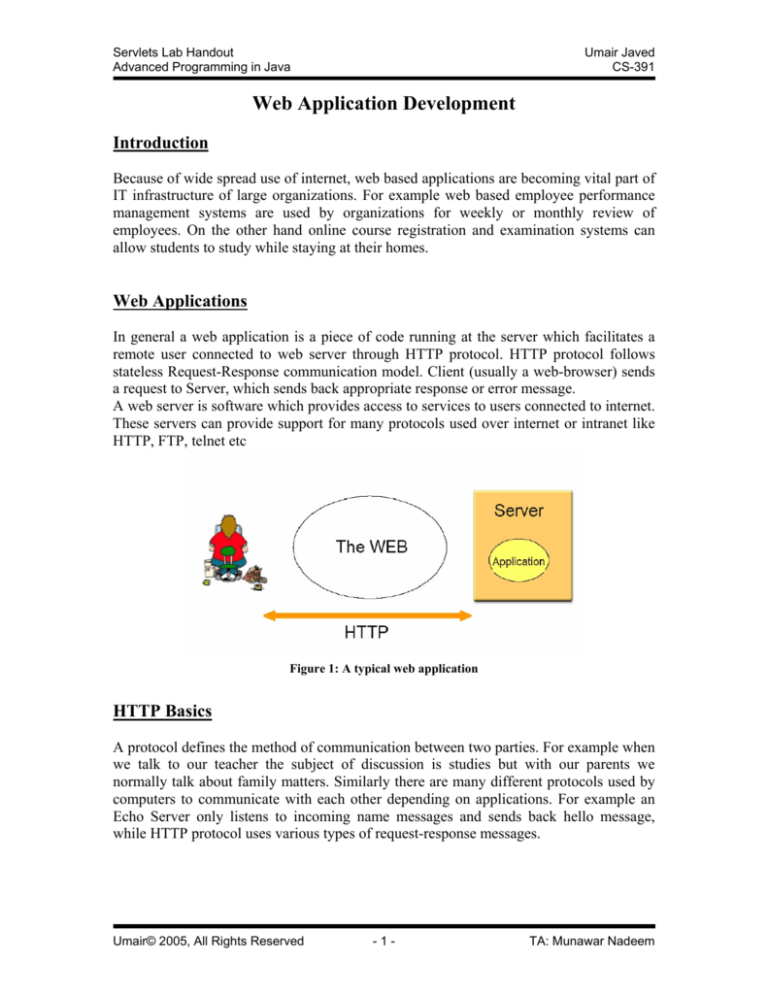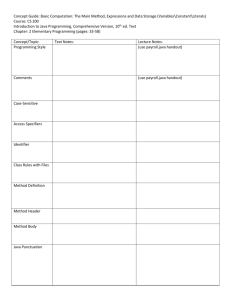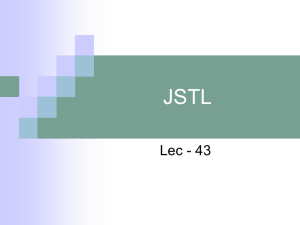
Servlets Lab Handout
Advanced Programming in Java
Umair Javed
CS-391
Web Application Development
Introduction
Because of wide spread use of internet, web based applications are becoming vital part of
IT infrastructure of large organizations. For example web based employee performance
management systems are used by organizations for weekly or monthly review of
employees. On the other hand online course registration and examination systems can
allow students to study while staying at their homes.
Web Applications
In general a web application is a piece of code running at the server which facilitates a
remote user connected to web server through HTTP protocol. HTTP protocol follows
stateless Request-Response communication model. Client (usually a web-browser) sends
a request to Server, which sends back appropriate response or error message.
A web server is software which provides access to services to users connected to internet.
These servers can provide support for many protocols used over internet or intranet like
HTTP, FTP, telnet etc
Figure 1: A typical web application
HTTP Basics
A protocol defines the method of communication between two parties. For example when
we talk to our teacher the subject of discussion is studies but with our parents we
normally talk about family matters. Similarly there are many different protocols used by
computers to communicate with each other depending on applications. For example an
Echo Server only listens to incoming name messages and sends back hello message,
while HTTP protocol uses various types of request-response messages.
Umair© 2005, All Rights Reserved
-1-
TA: Munawar Nadeem
Servlets Lab Handout
Advanced Programming in Java
Umair Javed
CS-391
Figure 2: HTTP communication model
-
-
HTTP is as request-response oriented protocol.
It is a stateless protocol since there is no built-in state management between
successive requests.
Parts of an HTTP request
o Request Method: It tells server what type of action client wants to be
performed.
o URI: Uniform Resource Indictor specifies the address of required
document.
o Header Fields: Option headers can be used by client to tell server extra
information about request e.g. client software and content type that it
understands.
o Body: Contains data sent by client to server
Other request headers like FROM (email of the person responsible for request)
and VIA (used by gateways and proxies to show intermediate sites the request
passes) can also be used.
Figure 3: HTTP request example
-
Request can also contain addition information in form of request parameters
o In URL as query string e.g.
http://www.gmail.com/register?name=ali&state=punjab
o As part of request body (see Figure 1)
Umair© 2005, All Rights Reserved
-2-
TA: Munawar Nadeem
Servlets Lab Handout
Advanced Programming in Java
-
Umair Javed
CS-391
Parts of HTTP response
o Result Code: A numeric status code and its description.
o Header Fields: Servers use these fields to tell client about server
information like configurations and software etc.
o Body: Data sent by server as part of response.
Figure 4: HTTP response example
-
HTTP codes fall into five general categories
o 100-199
Codes in the 100s are informational, indicating that the client
should respond with some other action.
100: Continue with partial request.
o 200-299
Values in the 200s signify that the request was successful.
200: Means every thing is fine.
o 300-399
Values in the 300s are used for files that have moved and usually
include a Location header indicating the new address.
300: Document requested can be found several places; they'll be
listed in the returned document.
o 400-499
Values in the 400s indicate an error by the client.
404: Indicates that the requested resource is not available.
401: Indicates that the request requires HTTP authentication.
403: Indicates that access to the requested resource has been
denied.
o 500-599
Codes in the 500s signify an error by the server.
503: Indicates that the HTTP server is temporarily overloaded and
unable to handle the request.
Umair© 2005, All Rights Reserved
-3-
TA: Munawar Nadeem
Servlets Lab Handout
Advanced Programming in Java
Umair Javed
CS-391
Server Side Programming
Web server pages can be either static pages or dynamic pages. A static web page is
simple HTML (Hyper Text Transfer Language) file. When a client requests an HTML
page the server simple sends back response with the required page.
Figure 5: Static web page request and response
While in case of dynamic web pages server consists of a running application which
generates HTML web pages according to specific requests coming from client. These
dynamically generated web pages are sent back to client with the response.
Figure 6: Dynamic web page request and response
We need to create dynamic web pages when the content of site changes frequently and
client specific response is required. Some of the scenarios are listed below
-
The web page is based on data submitted by the user. e.g. results page from search
engines and order confirmation pages at on line stores.
The Web page is derived from data that changes frequently. e.g. a weather report
or news headlines page.
Umair© 2005, All Rights Reserved
-4-
TA: Munawar Nadeem
Servlets Lab Handout
Advanced Programming in Java
-
Umair Javed
CS-391
The Web page uses information from databases or other server-side resources.
e.g. an e-commerce site could use a servlet to build a Web page that lists the
current price and availability of each item that is for sale.
Server side programming involves
-
Using technologies for developing web pages that include dynamic content.
Developing web based applications which can produce web pages that contain
information that is connection-dependent or time-dependent.
Dynamic web content development technologies have evolved through time in speed,
security, ease of use and complexity. Initially C based CGI was used to write server side
programs which were to provide limited but fast services to users. Then template based
technologies like ASP and PHP were introduced which allowed easy of use for designing
complex web pages. Sun Java introduced Servlets and JSP that provided more speed and
security as well as better tools for web page creation.
Figure 7: Dynamic web content technologies evolution
Normally web applications are partitioned into three layers. Each layer performs a
specific functionality which should not be mixed with other layers. Layers are isolated
from each other to reduce coupling between them but they provide interfaces to
communicate with each other.
-
-
Presentation Layer: Provides user interface for client to interact with the
application. This is the only part of application visible to client.
Business Layer: The business or service layer implements the actual business
logic or functionality of the application. For example in case of online shopping
systems this layer handles transaction management.
Data Layer: This layer consists of objects that represent real-world business
objects such as an Order, OrderLineItem, Product, and so on.
Umair© 2005, All Rights Reserved
-5-
TA: Munawar Nadeem
Servlets Lab Handout
Advanced Programming in Java
Umair Javed
CS-391
Figure 8: Simplified view of a web application and its layers
Java technologies for web application development include Java Servlets, Java Server
Pages, EJB, Java Server Faces and etc.
Figure 9: Java web application technologies (presentation/web tier)
Umair© 2005, All Rights Reserved
-6-
TA: Munawar Nadeem








